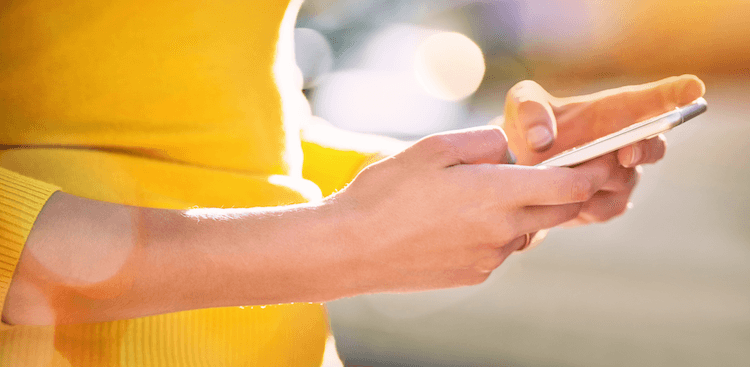Cell phones have come a long way. Back in the day, they were the size of bricks—remember the Zack Morris phone?!—and their only purpose was to make calls (and, let’s be real, even that cost an arm and a leg).
Fast forward to today, and we’re all walking around with supercomputers in our pockets. Everything we could ever want and need is just a few taps or swipes away. Which can be a blessing—or, if you’re me, a curse.
For years, I’ve been at the mercy of my phone: checking my email every 30 seconds, scrolling through social media at every break, falling into random Wikipedia holes when I should be getting to sleep. The way I used my phone wasn’t just unproductive—it was actually keeping me from living the kind of life I wanted to live.
So when the clock struck midnight on January 1st, I committed to trying the distraction-free phone so I could kick my phone addiction and lead a more present, connected life.
It’s been about seven weeks—and, at the risk of sounding cliché, it’s kind of changed my life. How, you might ask? Let’s take a look at what it was like to go distraction-free and the impact it’s had on my business, productivity, and overall well-being.
What Is a Distraction-Free Phone?
A few months ago, I stumbled upon Jake Knapp’s Medium article that outlined his addiction to mobile technology—and, more importantly, how he adjusted his cell to be more present for himself, his kids, and his career. He’s been rocking his distraction-free phone for six years and found new levels of personal and professional success as a result.
I related to Knapp on so many levels and was super inspired by his story. So I decided that my New Year’s resolution would be to follow in his footsteps.
Here’s how I adjusted my iPhone to go from “attention-sucking” to “distraction-free”:
- I deleted the email icon—and removed the single biggest distraction from my screen (and my life).
- I got rid of Safari access. As a self-proclaimed Wikipedia addict, this was also a serious time waster. (Side note: It took a bit of Googling to figure out how to get the Safari icon off my screen, but it is possible. It’s under Settings > Screen Time > Content and Privacy Restrictions > Allowed Apps.)
- I deleted all social media apps (which, for me, was Facebook and Instagram).
(Got an Android phone? No problem, you can go distraction-free, too! Check out this how-to guide to get started.)
Now, I could’ve tossed every app on my phone, but for this experiment, I only deleted things that were distracting—and kept useful apps that didn’t suck up a ton of my time (for example, Google Maps and Spotify).
The Withdrawal
Once I deleted all the notorious attention grabbers from my phone, I figured the transition would be easy; if my phone didn’t have anything on it to distract me, how could it be distracting?
Yeah… I was wrong.
I’ve spent years behaving as though my phone were surgically attached to my hand; it didn’t matter that there was nothing on my phone to check—checking my phone was like a muscle reflex.
The first few days, I compulsively picked up my phone just as often as I had when it was chock full of distractions. But there wasn’t really anything to hold my attention (other than pictures of my dog—which I definitely spent more than a few minutes scrolling through).
It took about a week for it to sink in that checking my phone wasn’t going to give me the “reward” of distraction that I was used to. And once it sunk in? Everything started to change.
The Adjustment Period
After that first week of obsessive phone checking, I could feel my phone addiction starting to lose its grip. I first noticed a shift one day when I was watching an episode of The Great British Baking Show.
Normally, when I watch television—even if it’s a series I love as much as this one—I’m really only half (or a quarter) watching; the bulk of my attention is directed toward email and social media feeds on my screen. This kind of multitasking means I don’t ever really absorb what I’m seeing—and end up rewatching the same episodes over and over before anything (the recipes, the challenges, the winner) commits to memory.
But this time, I made it the entire hour (that’s the signature challenge, the technical, and the showstopper) and didn’t even think to look at my phone. Not only did I enjoy the experience more, but I was also able to follow what I was watching (and learned some great tips for making meringue as a result).
Now, it seems like a small thing. But for me, being fully present for an entire hour of television felt like a pretty big deal. I got a taste of what life could be like if I wasn’t attached to my phone all the time—and, as Mary Berry would say, it was scrummy.
After that, I started leaving my phone behind, first for a few minutes at a time (like when I walked my dog) and then for larger, more significant chunks (like when I was pushing through a deadline). By the end of January, I became so comfortable not having my phone with me, I’d keep it at home when my husband and I went out for dinner, to run errands, or to take our pup to the dog park—and I ended up enjoying all those things even more than usual.
The Pay-Off
It’s been a little over a month since I started this experiment, and the payoff has been pretty amazing. I feel more present, I get more done, and I feel like I’m being more purposeful with my time. I know those are pretty broad terms (and sound like something you’d read in a self-help book)—so let’s dig deeper into how, exactly, my life has changed.
How the Distraction-Free Phone Impacted My Business and Productivity
- My business survived my scaling back on email. I didn’t think I’d be able to get by without constant access to email. But guess what? The world didn’t stop spinning when I didn’t answer every client email in 10 seconds or less. I still check my email often (usually about five or six times per day), but not being able to refresh my inbox on my phone has done wonders for my productivity.
- My productivity shot through the roof. Part of my job as a writer is to, you know, write. And in order to do that, I need to be in the zone. I’ve been able to get a ton more done because I’m not constantly pulled away from my writing (and out of the zone) by some unnecessary distraction on my phone.
- I went after new opportunities. I used to spend a lot of time mindlessly scrolling through my phone. After going distraction-free, I took that time back and spent a good chunk of it actively pitching new clients—which led to new assignments, connections, and opportunities.
How the Distraction-Free Phone Impacted My Life and Well-Being
- I reexamined my relationship with technology more broadly. Once I realized how happy I was without social media on my phone, I decided to give it up altogether—and deleted my Facebook and Instagram accounts completely (which has also been seriously life-changing!).
- I’m more present with the people I love. My friends, family, and husband love me—but they’ve all, at one point or another, commented on my phone use. Since my distraction-free phone experiment, I feel like I’m more present, and my relationships feel stronger (my husband has pointed out how nice it is to see me without a mobile device attached to my hand 24/7).
- I’m sleeping better. Blue light—like the light that radiates off electronic devices—can wreak havoc on your sleep. Since I’ve been on my phone less (and exposing myself to less blue light right before bed), I’ve been sleeping deeper, better, and longer—which makes me feel happier and more energetic throughout the day.
- I spend more time on things I care about. I was wasting a lot of time doing nothing on my phone. Now I have more time and energy for...well, everything. I’m spending more time on my hobbies, my personal relationships, and my health.
The Drawbacks
So, clearly, I’m on Team Distraction-Free Phone. But that doesn’t mean this experience hasn’t had its drawbacks.
The biggest challenge? While I definitely feel more present in my day-to-day life, I don’t feel as connected to the people, places, and things I don’t interact with on a daily basis. I don’t feel as on top of news and current events (if I want to know what’s going on in the world, I can’t just look down at my phone—I need to actively seek that out on my laptop or the TV), and because I don’t have my phone next to me as often, I can miss text conversations as they happen in real time. I’ve given my friends, family, and colleagues a heads-up about my phone situation, but I still feel bad when I get back to my phone and have a bunch of missed texts.
But at the end of the day, none of them even compare to the massive benefits (seriously—no one’s going to lose sleep if it takes me an hour to respond to a text).
Tips for Going Distraction-Free
Want to get your phone use under control? Here are my top suggestions based on my experience these past couple months:
- Don’t delete every app. You only need to get rid of apps that are actual distractions. If an app is convenient, useful, and doesn’t take up too much time, feel free to leave it on your phone. (The last thing you want is to have to walk around looking for Wi-Fi to download the Uber app next time you need a ride home.)
- Be compassionate with yourself. It can take a while to undo the “OMG WHERE’S MY PHONE” conditioning. If you notice you’re still checking your phone every five minutes—even after you go distraction-free—just give it time.
- Ask for support. If you’re tempted to check your email (yet again), your loved ones can gently remind you of your commitment to ease up on your phone usage.
- Turn on Do Not Disturb mode. If texts keep drawing you in after you delete your apps, use Do Not Disturb when you need even fewer distractions.
I’ve been going strong with the distraction-free phone for almost two months, and honestly, I can’t see myself ever going back. The benefits —like feeling more in control of my business, my time, and my life—are beyond worth the minor inconveniences.
And if I ever get the urge to fall down a Wikipedia hole? There’s always my laptop.

